ISL Managers Set Out Their Stall For Mentors At Dawn Of New Era In Swimming
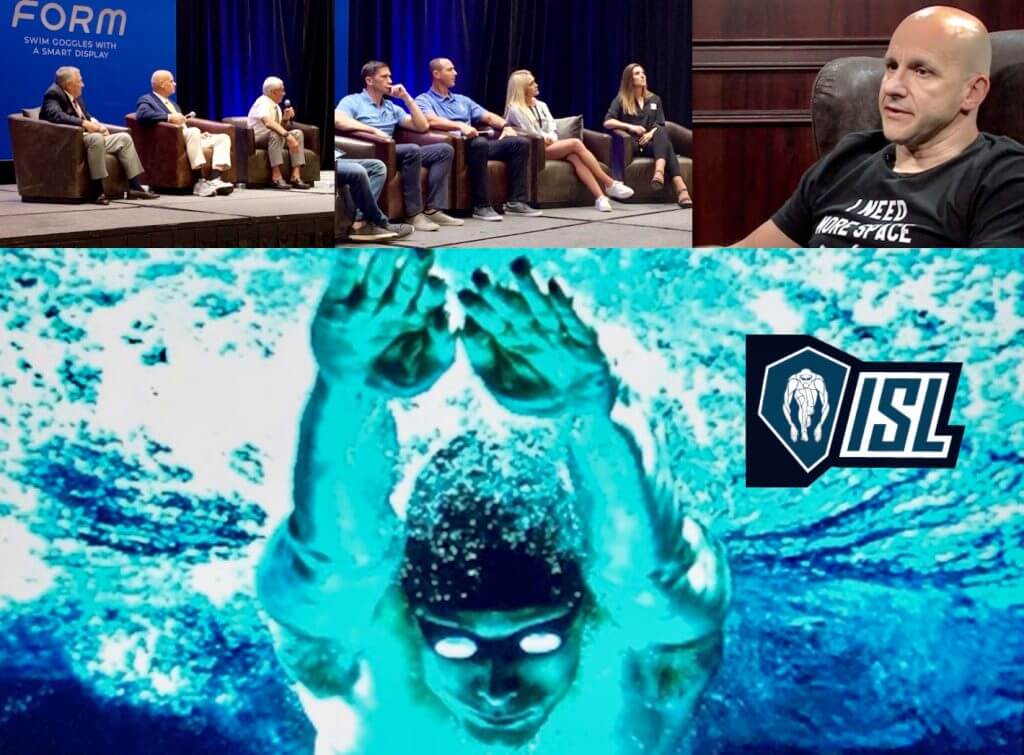
ISL Managers and Mentors Talk Through Challenges of New Pro Era
The International Swimming League (ISL), the pioneering global Pro-Team tour that gets its first season underway next month, offers “the only chance in history” to drag the sport into a truly professional era.
The quote came from John Leonard, the director of the American Swimming Coaches Association (ASCA) but the sentiment was echoed by all four managers of the four United States-based teams he introduced to a gathering of mentors here at the 2019 World Clinic in Dallas.
General Managers Kaitlin Sandeno (The DC Trident), Tina Andrew (NY Breakers), Jason Lezak (The Cali Condors, which has appointed Gregg Troy as its coach) and Lenny Krayzelburg (Los Angeles Current) explained the format and concept of the global league for professional swimmers and urged the world swimming community to embrace the new era with open warms.
Andrew, mother and manager of Team USA sprinter Michael Andrew, put it this way:
“A year from now, the sport is going to be so(…ooo) different. I urge coaches to get behind the ISL, get behind your athletes … let them dream crazy dreams, let them know there’s an incredible future for them earning a living doing the sport they love.”
The ISL tour gets underway next month, the first-season Team champion set to be declared at a grand finale of four teams in Las Vegas on December 21. Six knockout rounds, each featuring four of the eight teams on rotation, will dictate which squads take their sport to the Mandalay Bay Resort and Casino for the first decisive showdown of the League.
Revenue, including a prize pot of $US5.3 million, will be distributed on the basis of a 50:50 share between athletes and their teams on the one side and the business of the ISL on the other.
The investment poured into the ISL by its president and financier Konstantin Grigorishin, head of the Ukraine-based Energy Standard group, tops $20 million. That figure may be much greater still counting the costs of legal action, stretching to support for a class action from swimmers, designed to get FINA, the international federation, to relinquish a monopolistic control on the sport that dates back to 1908.
In his introduction of the managers, Leonard looked back through swimming history and noted that “The Olympic Games came along and ever since people have said ‘magnificent’ but behind it was a whole bunch of people getting rich on the back of the young people creating the show”.
Athletes had been able to make money from their sport, in prizes and sponsorships in the past 20 years but that had not made them “professional sportspeople”. He added:
“A pro athlete gets paid to train and compete. For 100 years, organisations have been capitalising on athletes’ abilities without returning dollars to the people who bring the money in the door.”
Fair Share
The NBA’s line of “49 dollars in every 100 must end up in athlete pocket” is “where we want FINA and the ISL to go”, said Leonard. The ISL is committed to a 50:50 share.
Sandeno look in the rear-view mirror after celebrating the fact that she and Tina Andrew – along with London Roar coach Mel Marshall – are pioneers ensuring that women managers are shaping the way from the beginning of a new era. A four-time Olympic medallist, Sandeno said:
“This has been an era in which top athletes in the world have to have a job while they’re training. They are hustling with appearances and even working 9-to-5 jobs. How do we do that to our athletes when it’s the number one sport every four years [at the Olympics].
Double Olympic backstroke champion in 2000, Krayzelburg believed the ISL was about “making our athletes truly professional, with wages, fixed season and a focus on training and competition … creating [market value] and building home brands.”
American hero of the USA 4x100m free relay at Beijing 2008, Lezak simply said: “I wish there was something like this when was swimming. Many swimmers in my day had to go back home in their 20s to be able to afford to swim.”
Leonard suggested that the arrival of the ISL had prompted FINA to “suddenly come up with a whole pile off money that apparently wasn’t there before”. Coach Jon Urbanchek was among those who said the pressure being brought to bear by athletes and the ISL had set the sport on a better pathway.
Coaches should have little problem getting behind the League, said Leonard, because it would “take care of athletes … there are not many who coach for the money, most coach for one reason only: passion and our desire to take care of athletes.”
In a plea to coaches to spread the world of a league that offered swimmers the ability to earn a living from their sport, Leonard concluded: “We’ve got to fill the stands, look good on tv, it has to be exciting for audiences out there and everyone in this room. Both here in the U.S. and in Europe, we have to get people through the door.”
The Show
The big ISL spend includes travel and accommodation costs of teams but a great deal is being invested in innovative presentation, with light shows and entertainment for each round of the League. The ISL planners staged a trial run of sorts with a fabulous light show, packed stands at the Foro Italico in Rome and multi-national squads in the summer of 2017.
Details for the ISL proper are being kept under wraps for now but Dmytro Kachurovskyi, the ISL’s Program Development Director, told Swimming World: “This is not going to be like anything swimming has known before. We were in Naples last week to test some of the things we’ll be doing and, ‘wow’ … only when the sports sees it will it be able to have an idea of what swimming can look like. Things have been as they are for a long time.”
In each round of two-day events (featuring 18 races one day, 19 the next), teams will be assigned a set lane for the whole meet, making g it easy for audiences to quickly get to grips with which swimmers swim for which teams, branding and team colours tied into the light show and presentation of the event.
The championship concept of heats and finals is gone: each day will bring a two-hour session featuring two breaks in which the spectators will be otherwise entertained or can get up and get the food and drink without missing the action.
Those breaks will also serve as tactic windows for coaches who can have four swimmers – two men and two women – on the reserves bench. Switching swimmers will allow coaches and managers to switch tactics after seeing how their rivals are playing the game.
Revenue includes ticket sales, which open tomorrow, broadcast rights in a deal signed last week with Eurosport, and merchandising, each team developing branded products for fans and swim clubs the world over.
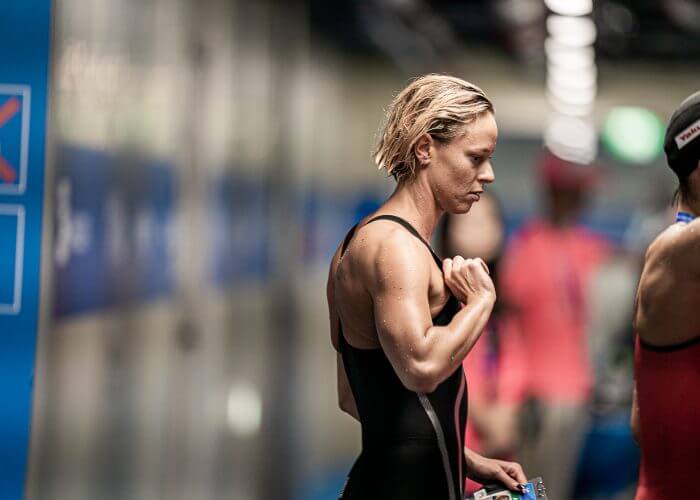
Federica Pellegrini – Photo Courtesy: Becca Wyant
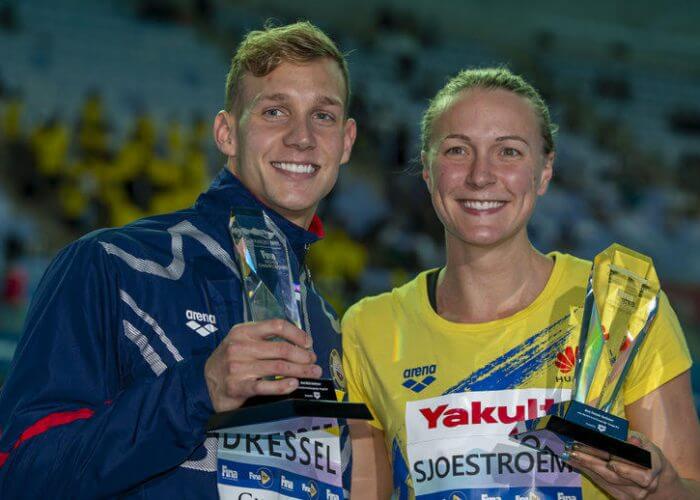
Caeleb Dressel (L) of the United States of America (USA) and Sarah Sjostrom of Sweden pose with the FINA trophy for the best male and female swimmer of the 2019 World Championships –
Photo Courtesy: Patrick B. Kraemer
Branding will also be significant to the market value of swimmers in the League: an Athletes’ Alliance is being established to consider the ways in which teams and then individual athletes can capitalise on their own brands and profiles. It is not hard to see how athletes such as Katie Ledecky, Caeleb Dressel, Adam Peaty, Federica Pellegrini, Katinka Hosszu, Florent Manaudou, Sarah Sjostrom and Chad Le Clos might take a cut of every sale of a mug, t-shirt, poster, pen and pull buoy bearing their image.
The emphasis is not on the clock but winning, not on individuals but teams and the points they will accrue:
9, 7, 6 and descending are the respective scores for a win, as second place and so on in most races
Relays score double
Head-to-head skins events score triple, placing much on the shoulders of sprinters and their ability to step up not for just the one splash and dash but several in a session.
Each round will feature four teams, two USA-based, two Europe-based. All teams including up to 32 swimmers each (12 men and 12 women will race in each round) from the pool of the best all over the world.
The League:
- 5-6 October 2019 – IU Natatorium, Indianapolis, USA
- 12-13 October 2019 – Aquatic Swimming Complex, Napoli, Italy
- 19-20 October 2019 – The LISD Westside Aquatic Center, Lewisville, Texas, USA
- 26-27 October 2019 – Duna Area, Budapest, Hungary
- 16-17 November 2019 – Natatorium at the Eppley Recreation Center, Maryland, USA
- 23-24 November 2019 – London Aquatic Centre, Great Britain
- 20-21 December 2019 – Mandalay Bay Resort and Casino, Las Vegas, USA
How To Balance League and Olympic Games Ambitions
There is much talk in the sport about how athletes will manage to keep their focus on their Olympic ambitions while fulfilling League duties and contractual obligations.
Grigorishin has made clear from the start that the League and its team concept is specifically aimed at creating a show that raises swimming’s profile in between Olympics without the need for constant peak-form clock watching for world records and punishing championship schedules.
Tina Andrew said the handling of it all would come down to “each team working with individual athletes on what’s best for them”. Part of the mission was “to have the athlete understand what it will take will take from them; what things they have to change as they start to travel more and do things in a different way”.
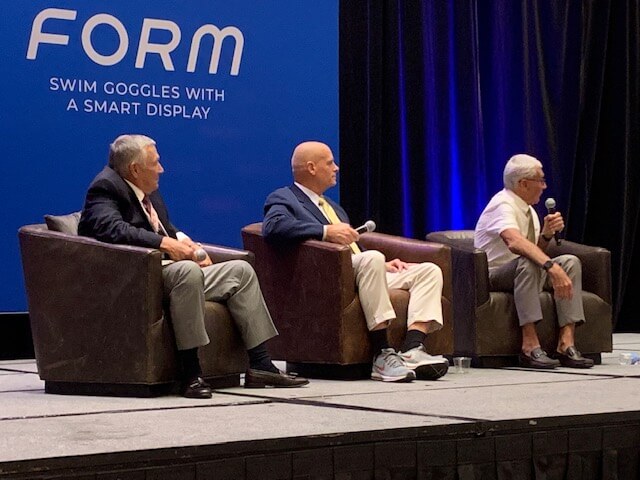
Coaches on stage (left to right) – Mark Schubert, Dennis Pursley and Join Urbanchek – Photo Courtesy: Craig Lord
After the ISL managers session, Mark Schubert, Dennis Pursely and Jon Urbanchek took to the stage with Chuck Warner to talk through approaches to Olympic year.
Schubert agreed with the concern USA team director Lindsay Mintenko had raised at a meeting earlier that day: “…how would athletes manage to compete at all the ISL events when training”.
Schubert’s take: “The home coach needs to direct the program … the Olympics has to be the most important thing. When you win an Olympic gold you win a lot of money, too.”
That view is common in a sport that has no intention of giving up the Olympic dream but will indeed have to find strategies for those who want to earn a good living through the League without spoiling their chances of excelling when racing at what will remain the biggest moment for swimmers wearing national colours.
Pursely thoughts it important to find balance, saying: “The ISL is a great concept but I agree with Mark that they [swimmers and coaches] have to get the balance right. Developing the schedule is important: my observations over decades has been that some have tried to have it all and have not succeeded. We’ve had circuits where they can earn money and those who tried to do it all seldomly stood on an Olympic podium. They need to chose their priorities.”
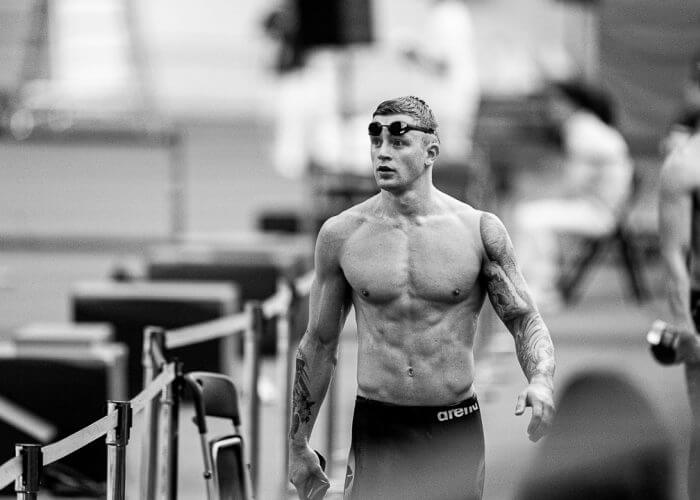
Adm Peaty – Photo Courtesy: Becca Wyant
That, in effect, is what is already happening. Britain’s Adam Peaty, for example, will race for London Roar, the manager and coach of which are his own manager and coach, respectively Rob Woodhouse and Mel Marshall. Peaty is unlikely to show for every round of the League, his absence part of the tactical considerations managers must give to selecting teams for specific events based on the relative strengths and weakness of their rivals.
Urbanchek was optimistic that balance could be struck and urged coaches to get behind the ISL because “we’re seeing how athletes now have a say so and the sport is heading in the right direction”.
Grigorishin pointed out early on in planning that the League was not there to demand peak form and ruination of Olympic plans. He was also critical of the current model in place in swimming, which treated athletes like “lab rats”.
When the billionaire met FINA leaders, one of the first things he asked them was this: “… you call yourself the FINA family, so how come you treat your children so badly.”
The World Championships and Olympic Games cycle, he believes, has created a culture and environment in which “the rarity of major competition once every two or four years means that athletes are treated as expendables; the next Olympic cycle will bring new ones. That also manifests itself in terms of the athlete having no institutional voice unless they are chosen by the institution; they are not reckoned with as individuals, unlike NBA players, for example.” He adds:
“They are expendable. Not even slaves, just expendable because at the end of their career they are gone and new ones come along.”
Grigorishin gives his views on sport and its future in a three-part mini series of videos, in Russian with English subtitles. Here is Part 3 – on the nature of the show that’s been and the show to come, athlete welfare moving up the aerial:
https://isl.global/konstantin-grigorishin-pt-3-challenges-of-the-modern-sports/
Grigorishin also argues that the very people setting doping rules also encourage athletes to break world records, to exceed human limits. “In that way, we see that they also motivate athletes to cheat,” says Grigorishin. “If you ask most athletes why they should not take doping, they [often] don’t tell you the most important thing: it destroys their health.”
“If the current paradigm of high performance sport defines ‘the result’ as the necessity to push the athlete to levels of performance that often exceed the natural limits of the human body – this is an indirect motivation for the athlete to resort to various performance enhancers (not only substances), in other words doping, which could be extremely harmful to a person’s health.”
He told this author: “Olympic sport is built on the assumption that the athlete should deliver a most remarkable result once in four years and his/her entire sports career banks on achieving that particular result. In that context the so-called ‘fight against doping’ sentiment coming from the IOC is sheer hypocrisy and lip service.”
He added: “Sport should not be judged to pose an undue risk to the health and safety of its athletes or participants. The sport proposed should in no way be harmful to any living creature.“
More on that, the League and the thoughts of Grigorishin in the October edition of Swimming World Magazine.




